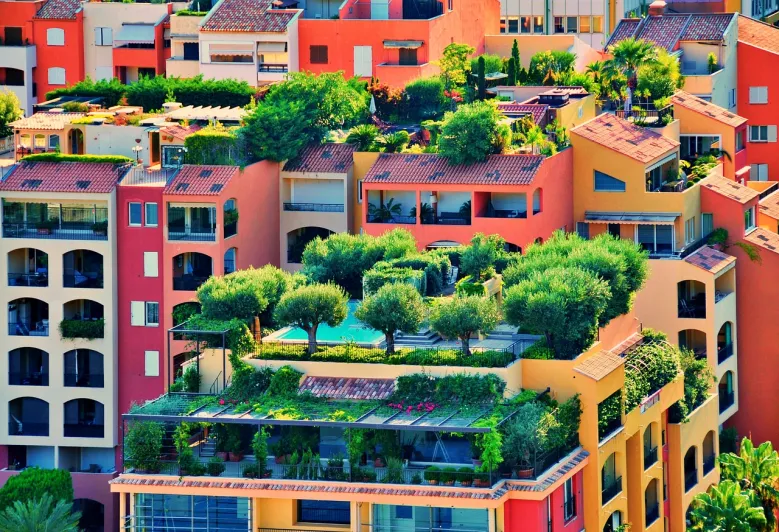Rooftop gardens appear as a ray of hope and sustainability in the busy center of metropolitan landscapes where concrete jungles rule the skyline. Elevated green areas are essential for improving the quality of life for Urban residents and modifying the surrounding environment. In addition to adding a touch of natural beauty to the development of cities. In a world where fighting pollution is becoming increasingly important, rooftop gardens turn pollution into a non-issue.
A garden created on a building’s roof is known as a rooftop garden. In addition to being eye-catching, these gardens may reduce total heat absorption, provide food (if they are vegetable gardens), improve architecture, and provide leisure activities. Food cultivation in these gardens is known as ‘rooftop farming.’
BENEFITS OF ROOFTOP GARDENS
Rooftop gardens can reduce the warming effect of cities which is one of its main benefits. The absorption and radiation of heat by concrete and asphalt causes cities to frequently suffer greater temperatures than the surrounding rural regions. On the other hand, vegetation on rooftop gardens minimises the warming effect of cities by providing shade and lowering the amount of heat absorbed by buildings. This lowers the amount of energy needed for cooling while also making the living space warmer and more comfortable.
Rooftop gardens offer protection against noise as well as temperature variations. Plants and soil work together to absorb, reflect, or deflect sound waves, which greatly reduces noise levels within the building—especially low-frequency noises.
This has the potential to significantly reduce noise pollution in populated areas, places close to airports, and areas beneath flight routes.
Rooftop gardens offer an extra degree of security to structures by functioning as a natural insulator in addition to regulating temperature. By lowering energy use for both heating and cooling, this insulation contributes to the energy efficiency of buildings. As a result, the carbon footprint of urban areas is diminished, aligning with global efforts to combat climate change.
In addition, the vegetation on top of buildings acts as an effective carbon sink by producing oxygen during photosynthesis and collecting carbon dioxide. This helps offset the carbon emissions from urban activity as well as make the air cleaner. Rooftop gardens are a breath of fresh air in the never-ending battle against air pollution.
The psychological and physical health of urban residents is just one of the many advantages that rooftop gardens have over the environment. These high natural spots provide a peaceful escape from the activity of the concrete jungle below. They turn into peaceful havens where people can relax, get away from the hustle and bustle of the city, and reconnect with the natural world.
Numerous positive effects on mental health, such as lowered levels of stress, anxiety, and depression, have been linked to exposure to green environments. By bringing nature closer to city inhabitants, rooftop gardens help build stronger, healthier communities. They promote a feeling of community and well-being by offering chances for leisure, interaction with others, as well as urban farming.
Furthermore, rooftop gardens may be extremely important for urban agriculture, which supports sustainable food production inside city borders. By using vertical space and creative gardening methods, these green rooftops may produce a range of crops, lowering the environmental impact of long-distance food transportation and promoting local food security.
Apart from providing a variety of bushes, trees, plants, and invertebrates for harvesting, rooftop gardens may serve as an ideal home for numerous birds and serve as a stopover for migrating species.
Collaboration between legislators, architects, and the community is necessary to create rooftop gardens. Policies and incentives that support the incorporation of green roofs into urban design can help create a more resilient and sustainable future. Green roofs are already widely used in some cities, such as Singapore and Copenhagen which is an example for other cities to follow.
CONCLUSION
Rooftop gardens have the power to significantly transform urban jungles into lively, versatile, and environmentally friendly environments. An elevated green paradise above presents an attractive solution to the problems of growing urbanisation and pollution that cities continue to face. By making investments in rooftop gardens, we can build communities that benefit the planet’s health and well-being in addition to their economic prosperity.
- About the Author
- Latest Posts
A passionate advocate for all natural and sustainable ideas. With a background in sustainable economics science and a deep love for nature, Sojy has dedicated his career to promoting eco-friendly practices and encouraging others to live a more sustainable lifestyle. He is an avid hiker, gardener, and cook, and loves experimenting with natural ingredients in his recipes and lifestyle routines. Sojy believes that small changes can make a big impact and is constantly seeking out new ways to reduce his carbon footprint and inspire others to do the same




